The human eye is an impressive thing. It contains two types of powerful photoreceptors — cone cells which can distinguish between approximately 10 million individual colors, and rod cells that are sensitive enough to respond to even a single photon of light. Its ciliary muscles are able to change focus up to 50 times per second, and experiments by scientists at MIT showed that the visual cortex can process and correctly identify images seen for as little as 13 milliseconds. However, human vision still has its limitations, even for those of us who don’t require corrective optics.
Unlike eagles, whose vision is sharp enough to track prey animals from two miles away, we can’t see much detail on small objects at great distances. Compared to many nocturnal species, our vision in low-light conditions is truly abysmal. And then there’s the fact that we can only detect light in wavelengths between 380 and 700 nanometers, effectively making us blind to ultraviolet and infrared light that other animals can perceive.
Fortunately, humanity’s greatest strengths — our intelligence and ability to make tools — have led us to solutions to all of these deficiencies. Magnified optics help us see further, image intensifiers (aka night vision devices) amplify traces of light, and specialized sensors detect energy wavelengths far beyond the visual spectrum. In this article, we’ll take a look at some of these categories of optical enhancements and their generalized pros and cons for well-rounded emergency preparedness.
Binoculars
Typically referred to as “binos,” binoculars mimic and enhance the average human’s natural two-eyed vision. You’ll typically see them described based on their magnification power and objective lens diameter, typically expressed as a pair of numbers (e.g., 10×50). The first number indicates the magnification power. The second number is the diameter of the objective lens in millimeters, which affects light-gathering ability and overall image brightness. Larger lenses can take in more light, and therefore perform better around dusk or dawn or during overcast conditions. The field of view refers to the width of the area visible through the binoculars at a specific distance, usually measured in feet at 1,000 yards. A wider FOV is beneficial for tracking moving objects and scanning large areas, making it essential for activities like bird watching and sports.
Binoculars use prisms to correct the orientation of the image. There are two main types: roof prisms and porro prisms. Roof prism binoculars are more compact and lightweight, while Porro prism binoculars are bulkier but often provide a better depth of field and a wider FOV at a lower cost. Optical coatings on the lenses reduce glare and improve light transmission, enhancing image clarity and contrast. Terms like “fully coated,” “multi-coated,” and “fully multi-coated” describe the extent and quality of these coatings. Fully multi-coated lenses provide the best performance, especially in low-light conditions. Eye relief is the distance from the eyepiece to your eye where the full field of view is visible. It’s a crucial feature for those who wear glasses, as sufficient eye relief ensures a comfortable viewing experience without removing eyewear. Typically, an eye relief of 15mm or more is ideal for glasses wearers.
Our search for a solid midrange, high-performance binocular led us to the 5 Primal by Riton Optics. Constructed with a lightweight aluminum alloy and coated in rubber armor, they provide a secure grip and can withstand harsh conditions. The 10×42 ED configuration ensures sharp, clear images with excellent color fidelity. Fully multi-coated lenses enhance light transmission for bright visuals even in low-light settings. Waterproof and fog proof, these binos are reliable in diverse
weather conditions.
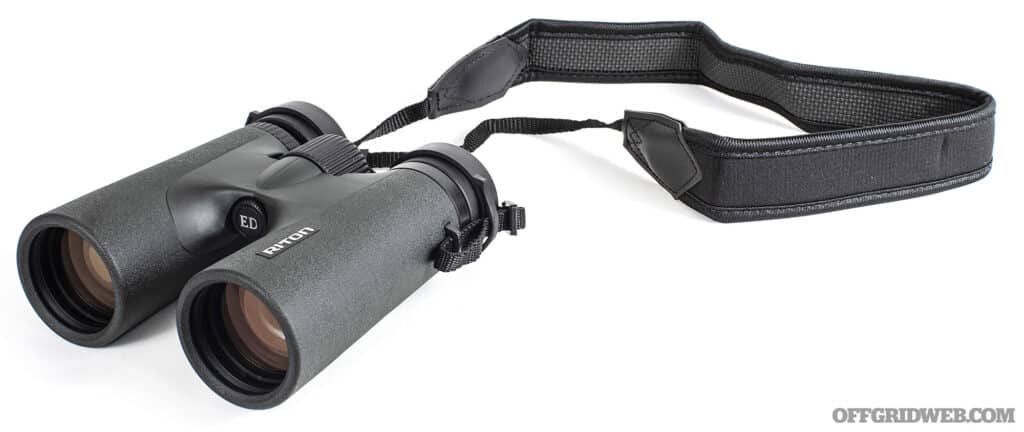
Make & Model: Riton – 5 Primal 10×42 ED
MSRP: $650
URL: ritonoptics.com
Pros:
- Binos allow us to take advantage of both our eyes, not just one, offering improved depth perception, spatial awareness, and reduced visual strain.
- Moderate magnification and wide FOV make them well-suited to scanning an environment and locating targets.
- Many binoculars, including the Riton 5 Primal, can also be adapted to a tripod for extended use in stationary positions.
Cons:
- Although made with lightweight materials, hand-holding any set of binoculars may still feel tiring during extended periods of observation.
- There’s a substantial trade-off between portability, image quality, and cost. Bigger objective lenses will yield a brighter image, but high-quality glass is expensive and heavy.
Spotting Scope
Technically a subcategory of telescopes, spotting scopes are designed for observation of faraway objects without all the bulk and weight of a full-size telescope. And rather than gazing up at the stars, these devices help us with more practical terrestrial tasks such as surveillance, hunting, and precision shooting. Unlike rifle-mounted scopes or handheld binoculars, which are designed with portability in mind, spotting scopes are typically supported by tripods. This means they can use a much larger objective lens to gather the maximum amount of light, producing a clearer and brighter image. Most spotting scopes are designed purely for observation, but more specialized models incorporate reticles which can be used to call out corrections while shooting or estimate distance to a target using stadiametric rangefinder markings or a ranging formula (object height in inches x 27.77 / height in MILs = distance in yards).
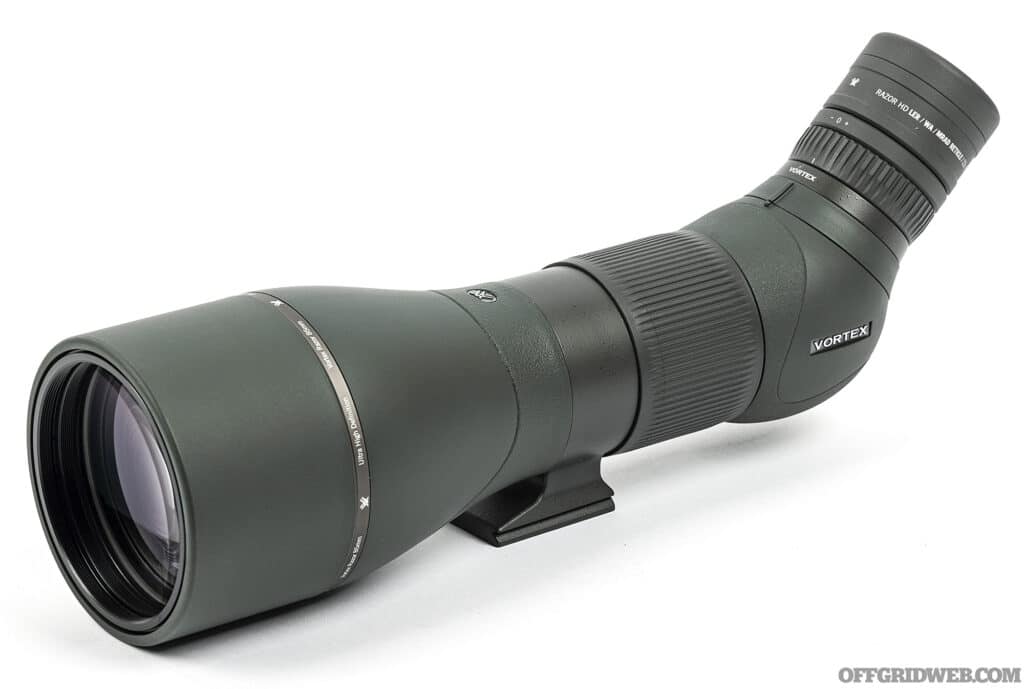
The spotting scope shown here is Vortex’s top-of-the-line Razor HD 27-60x85mm angled model. A straight-through variant is also available for those who prefer that style. The Razor HD features a massive 85mm objective lens with superb sharpness, light transmission, and color fidelity. The lens and prism both feature multiple coatings to maintain brightness and clarity, and the housing is purged with argon gas to make it both waterproof and fog proof. It comes with a versatile 27-60x zoom eyepiece, but we elected to swap it for the optional fixed-power 22x eyepiece with built-in MIL reticle ($575) for shooting and range finding.
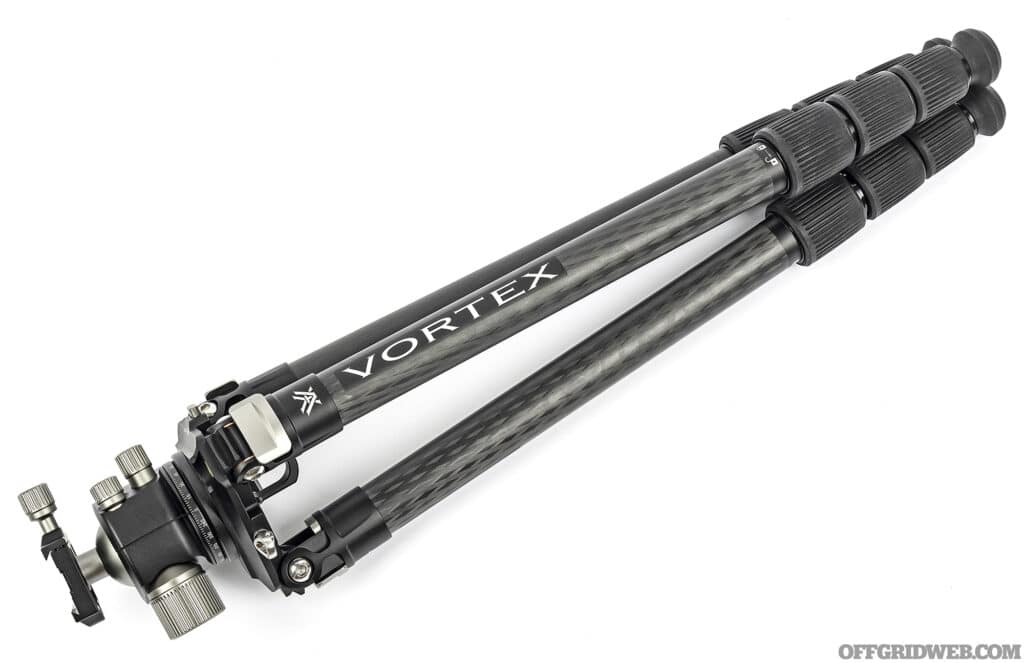
We paired this scope with a Vortex Radian Carbon tripod with ball head ($1,300). Each carbon-fiber leg has four sections for a wide range of height adjustment, and the large tension control knob makes precise adjustments easy. It’s compatible with any Arca-Swiss rail mount, such as the one built into our spotting scope or M-LOK-to-Arca rail adapters for rifles.
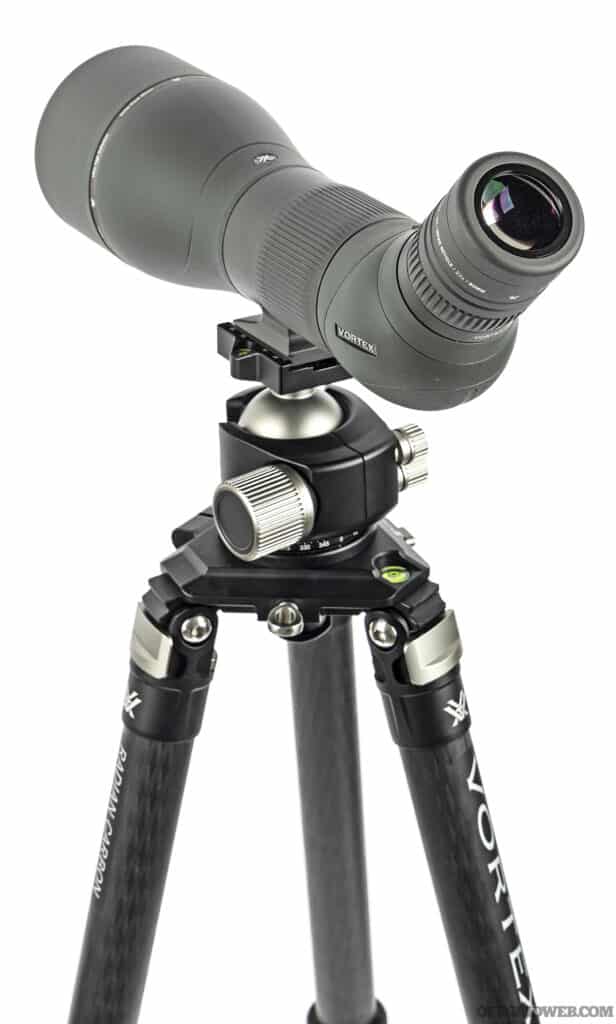
Make & Model: Vortex – Razor HD 27-60x85mm
MSRP: $2,400
URL: vortexoptics.com
Pros:
- Huge objective lens offers image quality and low-light performance that can’t be matched by most riflescopes and binos.
- Powerful magnification up to 60x with standard eyepiece
- Tripod support and angled design make it stable and comfortable enough to use for hours at a time.
- With the addition of a reticle, it can be used to observe, estimate range, and communicate precise corrections to a shooter using the same measurements as their riflescope.
Cons:
- Though it can be handheld, it’s intended for use with a tripod that must be purchased separately and carried along with the scope.
- Limited portability — best suited for static observation
- Models with reticles are often substantially more expensive and may eliminate zoom functionality.
- Large, high-quality glass comes at a substantial cost.
Monocular / Laser Rangefinder
It’s only 200 yards to that ridgeline over there. Once you get there, you should be able to see the rest of your route. Or is it 600 yards? Mental range estimation is a trained skill — one that requires substantial and routine training to do with any kind of consistent accuracy. Whether you’re ranging an animal in order to feed your family, a terrain feature you need to reach for a link-up, or even figure out how far away from your house an angry mob is, range finders are useful in a wide variety of situations that go far beyond shooting.

The amount of time you have to react to a potential threat is directly proportional to how far away it is from you. Do you really want to guesstimate how much reaction time you have? Range finders all work on the same principle: they send a beam of light (usually in the infrared spectrum) out to a point and measure the time it takes for that light to reflect back. Because the onboard computer is literally measuring the speed of light, accurate range readings are almost instantaneous. Depending on features, housing quality, maximum range, and glass quality, range finders can be found all along the price spectrum, from sub-$20 to several thousand.

Vortex rangefinders are available at various price points in several formats. We’ve used this Vortex Viper HD 3000 on many trips for tasks including search-and-rescue drills and precision shooting. Its 7x25mm monocular design fits easily into a standard pocket on a pair of jeans, but it’s still capable of accurately ranging a deer at up to 2,000 yards. The illuminated reticle is easy to see, even in full sunlight, and the glass quality is quite good despite the small objective lens. Alternatively, Vortex offers range-finding binoculars as well as a rail-mounted range finder with built-in ballistic calculator specifically for long-range shooting. It should be noted that weather conditions like rain, dust, or fog can impede the capability of range finders. But most units fit in the palm of your hand and weigh less than a pound, making a range finder an easy tool to build into any kit or bug-out bag without sacrificing large amounts of load carriage.
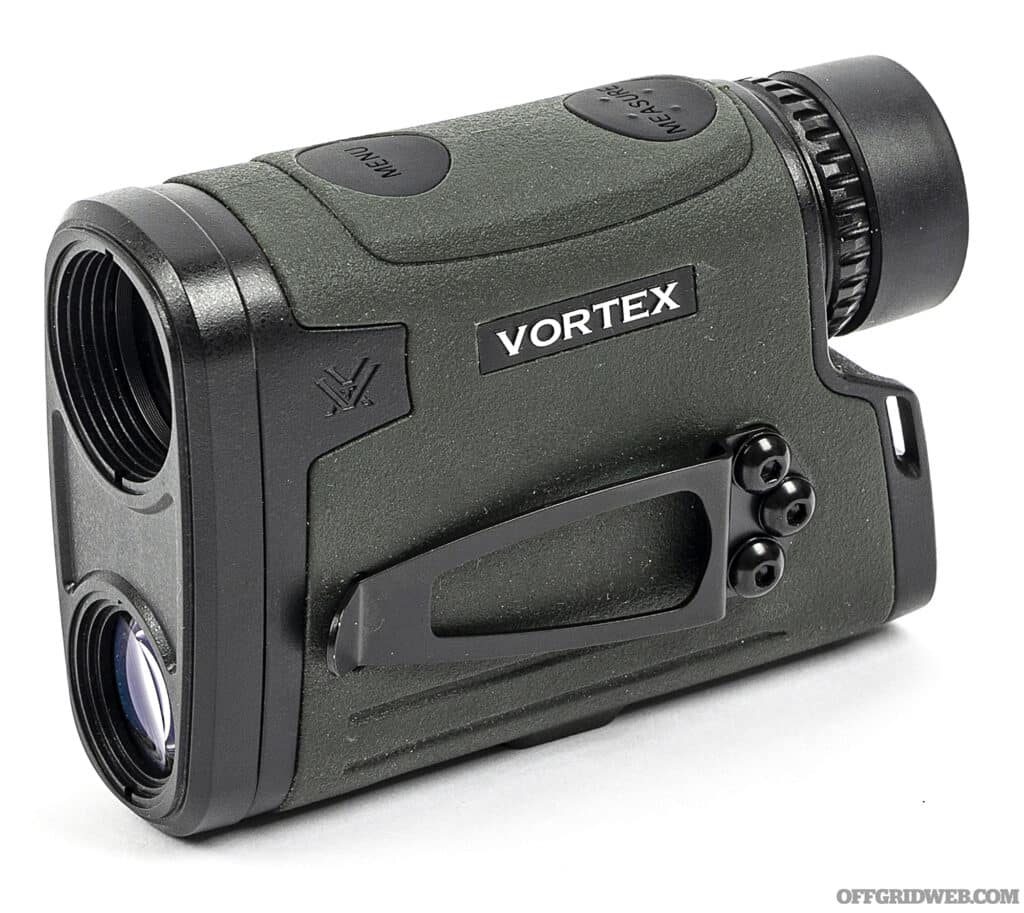
Make & Model: Vortex – Viper HD 3000 7x25mm
MSRP: $600
URL: vortexoptics.com
Pros:
- Monoculars are much lighter and more compact than traditional binos. Many even have pocket clips for on-body carry.
- Offers a moderate level of magnification for general-purpose observation
- Instantly gauges the distance to a target, making it easier to shoot, draw terrain maps, or estimate travel time
- One of the most versatile optic types. It’s useful for a wide variety of professions and hobbies — even golfing.
Cons:
- Learning all the target modes, ranging modes, and various settings takes some practice.
- May not provide accurate readings through glass and will be adversely affected by weather conditions such as rain or fog.
- If you only need an observation tool with the clearest possible image, your money may be better spent on a non-range-finding monocular or binos.
Analog Night Vision
Over the last several years, night vision has become exponentially more popular with both the shooting and preparedness communities. It offers the ability to enjoy recreational shooting at all hours of the day, train for and respond to threats in the night, and spot danger without the need to give away your own position. We heard it once referred to as “the only superpower you can buy,” and we’re inclined to agree. But, despite the rapid proliferation of this technology into the civilian market over the last couple of years, there are some considerations.
The first is cost. Usually, when a technology becomes more widely available, the price goes down. While night vision has gotten less expensive, it hasn’t gotten cheap. Even the most basic, entry-level, single-tube night vision device with less-than-ideal performance will set you back $1,500 to $2,500 just for the NVD itself. Which brings us to the next consideration: capability.

What do you want to do with your night vision? If you want to use it in conjunction with a firearm, you’re going to need at least one, if not several, accessories that are also rather costly. If you want the NVD mounted directly to your weapon, you’ll need a Picatinny rail adapter. If you want to use your NVDs hands-free, independent of your weapon — which is what we would generally recommend — you’ll need a helmet (or specialized headgear), a mounting shroud, and an adjustable mount. Each of those components will run you another several hundred dollars. Then, there’s the ancillaries, like taller optic mounts, or infrared flashlights and aiming lasers. A good IR aiming laser/illuminator can cost another several thousand dollars by itself. You get the picture.
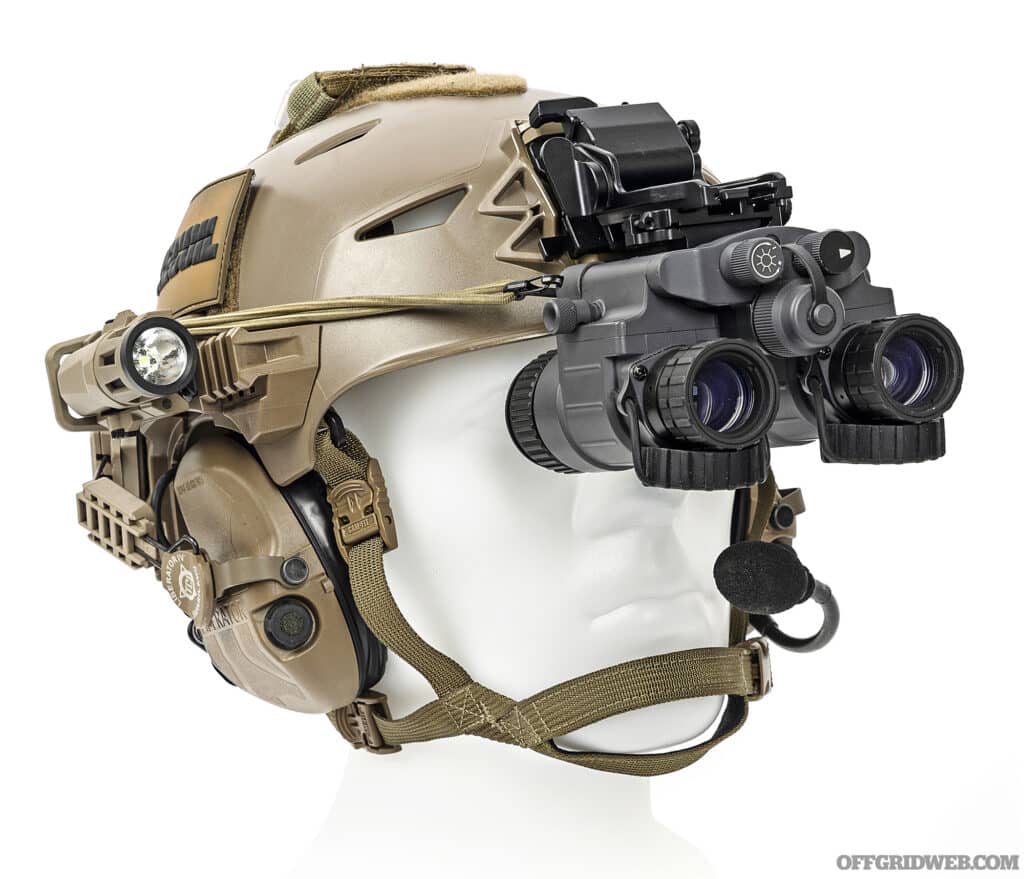
But if you approach it as an investment that is useful in a wide variety of scenarios — most of which don’t require a firearm — then the proverbial juice may be worth the squeeze. The night vision unit shown here is Armasight’s white phosphor BNVDs. These Gen III dual-tube NVDs use Armasight’s Pinnacle Elite tube. It is available as a stand-alone unit, or as part of Armasight’s night vision starter bundle, which also includes a Team Wendy helmet with shroud, Wilcox mount, and a branded OTTE Gear helmet bag — every one of these are top-shelf accessories suitable for professional users. This setup allows us to see clearly in the dark, hands-free, for hours at a time. Whether we’re on a night hike, spot trouble while hunkered down with the lights out, travelling across potentially dangerous terrain while remaining concealed to avoid trouble, or defending a home or business from looters and rioters, this setup will allow us to do it all without the need for any illumination other than a little moonlight.
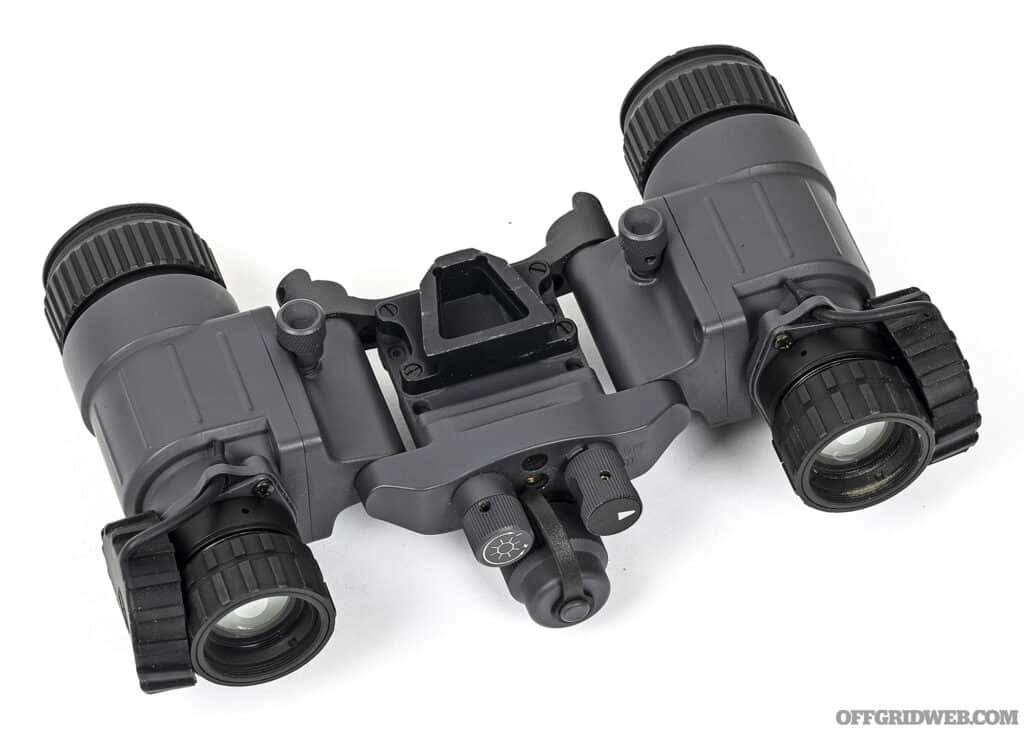
Make & Model: Armasight – BNVD-40 Gen 3 Pinnacle White Phosphor NVG
MSRP: $6,999
URL: armasight.com
Pros:
- Even the tiniest amount of ambient light can be intensified into a clear, high-contrast image.
- Unlike digital night vision, there’s no perceptible “lag” in the image, and battery life is dramatically improved.
- Analog NV technology has matured over decades and proven reliable, so there’s minimal risk of your NVD being made obsolete by a new model in a few years.
Cons:
- It’s easy to spend $10,000 or more on a high-end set of NVGs, and even an entry-level NV monocular can set you back thousands of dollars.
- Every analog image intensifier tube is different, resulting in a wide range of performance variations. You’ll need to do some research to ensure you spend your money wisely — we recommend starting with our deep dive into this topic in Issue 43.
Digital Night Vision
Digital night vision devices use digital sensors to amplify available light and create a visible image. These components convert low-light scenes into clear, full-color images, and can augment them with digital zoom and image enhancements. Built-in IR illuminators emit infrared light, which is invisible to the naked eye but can be detected by the night vision device. This feature enhances visibility in complete darkness, allowing users to see clearly without any ambient light. The quality of the display, often an LCD or OLED screen, affects the clarity and detail of the image. Higher-resolution displays provide sharper images, making it easier to identify objects and details in low-light conditions.
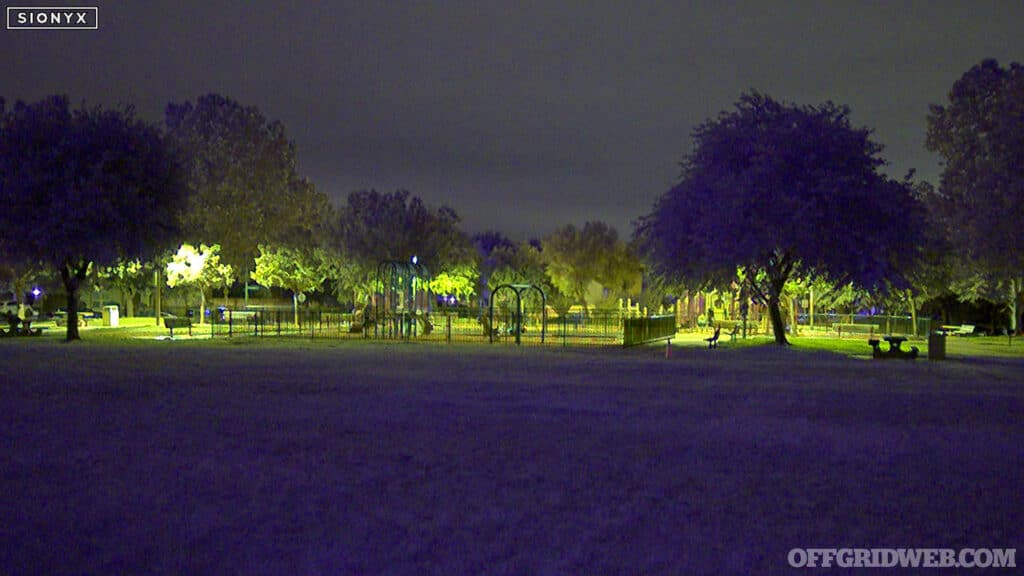
While digital night vision devices significantly enhance visibility in low-light conditions and offer full color capabilities, their image quality and responsiveness is often lower than traditional analog night vision, particularly in entry-level models. Issues such as graininess, noise, and lower resolution can affect the clarity of the image. Latency — a short delay between when the image is captured and displayed on the screen — is also a common issue and may feel disorienting to some users (especially in body-worn applications). Higher-end models offer better performance, but at a higher cost. However, this technology is improving rapidly, and many experts predict that digital NV will completely replace analog NV systems in the future.
The SIONYX Opsin Night Vision Monocular is designed for helmet-mounted nighttime visibility. With a 1920×1080 full HD CMOS sensor, it delivers clear, full-color visuals and has built-in video and audio recording capability. The monocular’s compact and lightweight design, weighing approximately 9 ounces, ensures easy portability for various uses. Its durable housing is water-resistant, rated at IP67, making it suitable for different weather scenarios. The device includes user-friendly controls and a rechargeable battery with up to 14 hours of continuous use. It even has a built-in compass and GPS coordinate tracking to help the user navigate. While its nearly $2,000 price is substantial, it offers impressive capabilities for those requiring a versatile night vision device.

Make & Model: Sionyx – OPSIN
MSRP: $1,995
URL: sionyx.com
Pros:
- Low cost compared to analog night vision optics.
- Consistent performance from one unit to the next — no need to carefully analyze tube specs or worry about distracting blemishes.
- Offers a detailed color image, rather than monochrome.
- Has the ability to record video, audio, and geo-tagged location, enabling users to document everything they observe.
Cons:
- Digital NV is developing very rapidly, so you’ll need to upgrade or swap frequently if you want to stay on the cutting edge.
- Unlike analog NV, digital still has a perceptible lag or latency that’s especially noticeable when moving quickly or tracking moving objects.
- Some users might find the digital controls and features complex to master initially.
- User will have to wait while it charges, unless extra battery packs are purchased.
Thermal
While night vision can amplify traces of existing light, thermal optics allow us to see heat energy that would otherwise be completely invisible. This type of optic feels like a superpower, whether it’s being used by a police helicopter to track a fleeing suspect or a hunter to watch prey in total darkness. Thermals are also becoming an increasingly large factor in warfare, since they make it possible to spot enemy troops from hundreds of yards, even through dense foliage and without a flicker of movement. From a more practical perspective, a handheld thermal optic can be used to find a lost pet, identify predators or rodent pests on your property, or even to spot moisture intrusion from a leaky pipe or roof.
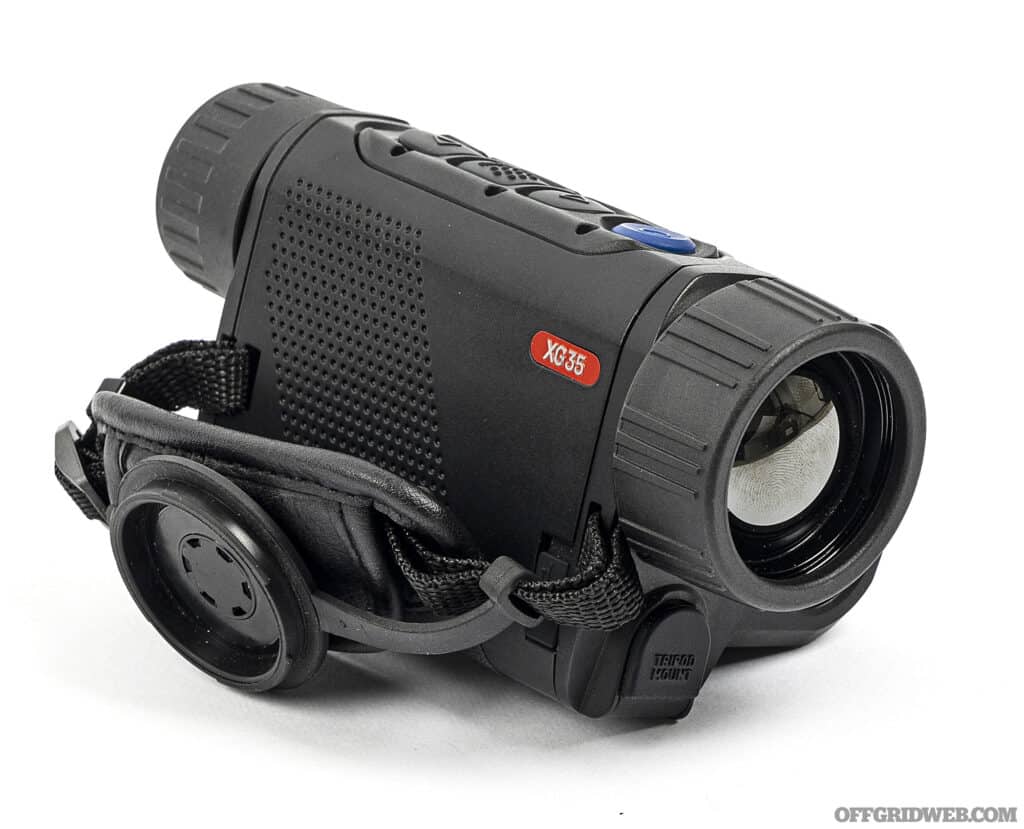
As an example of this category, Pulsar sent us their high-end Axion 2 LRF XG35, which integrates a laser range finder and thermal optic into a magnesium alloy monocular housing. The 640×480 12-micron sensor produces incredibly clear and vivid images on the high-contrast AMOLED display. Its laser range finder can measure out to 1,000 meters within an accuracy of a single meter.

Unlike thermals from the old days, it won’t burn through batteries in an hour or two — the included APS5 rechargeable battery provides up to 11 hours of runtime on a single charge and can be removed and swapped out in seconds. The Axion 2 also offers 8x digital zoom for a magnification range of 2.5x all the way to 20x, eight color palettes with fine-tuning adjustments, and pairs with an Android or iOS smartphone app for real-time viewing and video/image downloads. It even comes with 16 gigabytes of free cloud storage to ensure you can easily access recordings from anywhere.
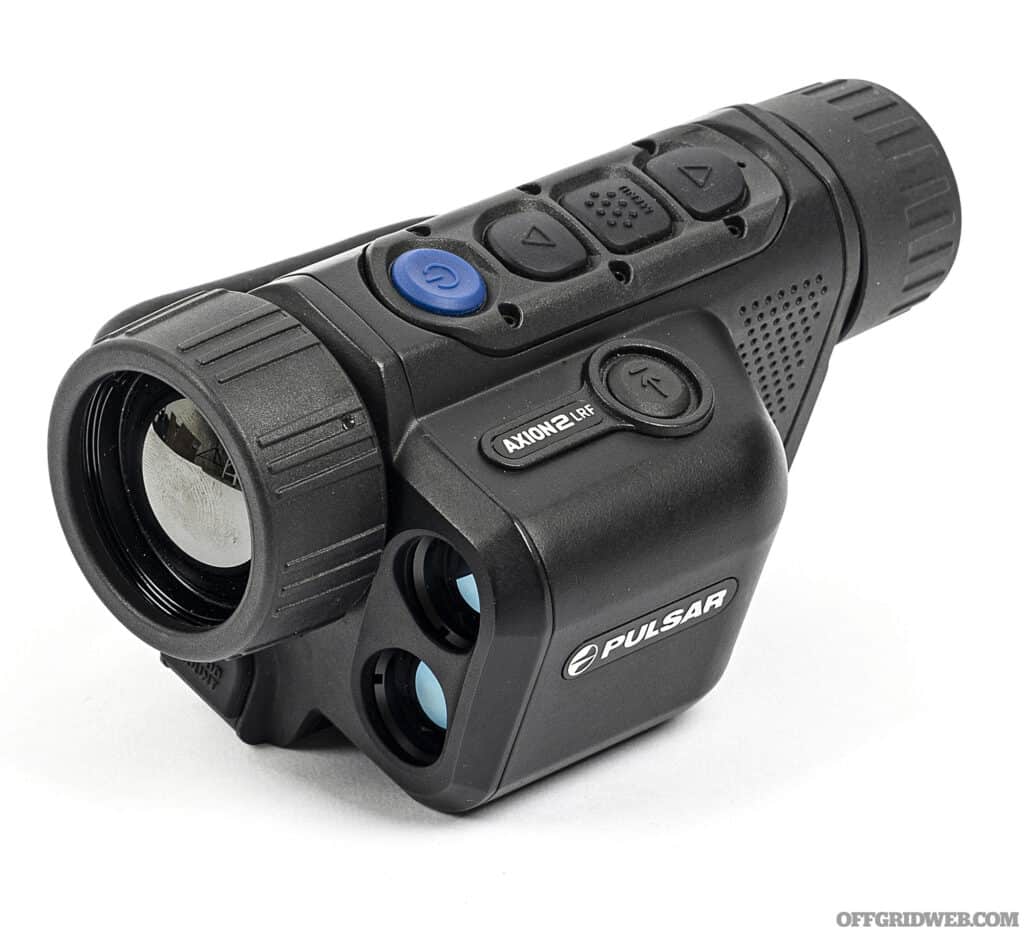
Make & Model: Pulsar – Axion 2 LRF XG35
MSRP: $3,400
URL: pulsarnv.com
Pros:
- Day or night, there’s no faster way to locate a warm-blooded creature.
- Unlike visible light, heat signatures are easy to see even if the target isn’t moving and/or is camouflaged against the background.
- Powerful search-and-rescue tool, whether you’re looking for a person, an animal, or traces of recent activity (e.g., a hot engine block in a vehicle)
- Built-in features like photo and video recording and range finding make this a versatile tool for observation or evidence-gathering.
Cons:
- Thermal tech is evolving at an incredible rate. Buy wisely, or you might spend thousands on a device that feels obsolete in a few years.
- Available in a variety of mounting styles: handheld, dedicated weapon-mounted, and clip-on (see Issue 59 for details on each). You’ll need to carefully consider the best type for your needs before committing to any of these.
- Modern batteries have come a long way, but these optics still guzzle electricity. Always bring a spare battery or USB power bank.
Read More
Subscribe to Recoil Offgrid's free newsletter for more content like this.
Editor's Note: This article has been modified from its original print version for the web
The post Pros and Cons of Optic Devices appeared first on RECOIL OFFGRID.
By: Patrick Diedrich
Title: Pros and Cons of Optic Devices
Sourced From: www.offgridweb.com/gear/pros-and-cons-of-optics/
Published Date: Thu, 15 Aug 2024 22:48:43 +0000
------------------------
Did you miss our previous article...
https://bushcrafttips.com/bushcraft-news/steelhead-outdoors-scout-25-review
 What is BushcraftSurvival SkillsToolsVideosBushcraft CampsBushcraft KitsBushcraft ProjectsPrivacy PolicyTerms And Conditions
What is BushcraftSurvival SkillsToolsVideosBushcraft CampsBushcraft KitsBushcraft ProjectsPrivacy PolicyTerms And Conditions
